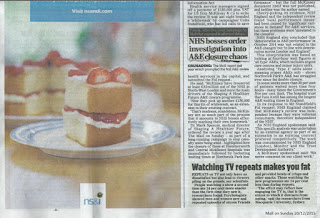Review found long A&E waits were 'unrelated' to the closures of two units.
Consultancy firm paid by the NHS had been paid millions for closure plan.
Authors' identity divulged only through Freedom of Information request.
Health service managers signed off a payment of £150,000 for the view.
NHS bosses have been accused of ‘marking their own homework’ over a review that claimed the closure of two A&E departments had little impact on other hospitals.
NHS bosses have been accused of ‘marking their own homework’ over a review that claimed the closure of two A&E departments had little impact on other hospitals. Above, Dr Mark Spencer, medical director for NHS NW London
NHS bosses have been accused of ‘marking their own homework’ over a review that claimed the closure of two A&E departments had little impact on other hospitals.
The ‘independent’ review, commissioned by NHS England, found that soaring waits for A&E treatment in North-West London were ‘unrelated to the closures’ of two casualty units in the area in September 2014.
Now it has emerged that the consultancy firm paid by the NHS to write the study was the same one already paid millions for coming up with the closure plan in the first place.
The NHS repeatedly refused to tell campaigners who had written it – only divulging the authors’ identity when forced to do so under the Freedom of Information Act.
Health service managers signed off a payment of £150,000 plus VAT for US firm McKinsey & Co to write the review. It was last night branded a ‘whitewash’ by campaigner Colin Standfield, who has led calls to save health services in the capital, and submitted the FoI request.
He said: ‘McKinsey have trousered at least £33 million out of the NHS in North-West London and were the main drivers of the Shaping A Healthier Future A&E closure programme.
‘Now they pick up another £150,000 for this tin of whitewash, as an extension to their existing contract.
‘That’s madness, scandalous. McKinsey are so much part of the process that it amounts to NHS bosses effectively marking their own homework.’
Dr Mark Spencer, medical director of Shaping A Healthier Future, ordered the review a year ago after The Mail on Sunday – as part of a long-running campaign to stop casualty units being axed – highlighted how the closure of those at Hammersmith and Central Middlesex hospitals was immediately followed by rocketing waiting times at Northwick Park hospital in Harrow.
That autumn, the proportion of patients having to wait four hours or more in Northwick Park’s A&E averaged 25 per cent – double the 11 per cent figure of autumn 2013.
At the time Dr Spencer said he did not think the closures were having a ‘major impact’ on other hospitals. But he promised: ‘We’ve asked for an external review… to see if there’s anything we need to learn to get it right. If we are wrong, we will find out how we got it wrong and not do it again.’
In July, NHS England published a ‘Review of the Implementation of North-West London A&E Changes’. It quoted from what was described as ‘the independent review of A&E performance’ – but the full McKinsey document itself was not published, and neither was the author named.
The ‘independent’ review, commissioned by NHS England, found that soaring waits for A&E treatment in North-West London were ‘unrelated to the closures’ of two casualty units in the area in September 2014
The ‘independent’ review, commissioned by NHS England, found that soaring waits for A&E treatment in North-West London were ‘unrelated to the closures’ of two casualty units in the area in September 2014 (stock image)
Cherry-picking its evidence, NHS England said the independent review found ‘local performance issues’ had been caused by ‘significant variances in demand’ for A&E services, but these problems were ‘unrelated to the closures’.
NHS England also concluded that ‘deterioration in A&E performance’ in October 2014 was ‘not related to the A&E changes’ but ‘in line with deterioration across London and England’.
This interpretation was based on looking at four-hour wait figures at ‘all type’ A&Es, which includes urgent care centres and minor injury units.
Analysing ‘Type 1’ units alone – meaning proper A&Es only – shows Northwick Park’s A&E has struggled ever since the double closure.
In some weeks more than 30 per cent of patients waited more than four hours – many times the Government’s five per cent limit. The hospital trust that runs it still has among the longest A&E waiting times in England.
In its response to Mr Standfield’s FoI request, NHS England claimed that McKinsey’s review was independent because they were ‘external consultants, therefore independent of the NHS’.
An NHS England spokesman said: ‘This specific analysis was undertaken by an external agency as part of an extension to an existing contract procured competitively. The work was commissioned by NHS England (London), Monitor and the Trust Development Authority.’
A McKinsey spokesman said: ‘We never comment on our client work.’
By STEPHEN ADAMS FOR THE MAIL ON SUNDAY
PUBLISHED: 01:51, 20 December 2015 | UPDATED: 12:53, 20 December 2015
PUBLISHED: 01:51, 20 December 2015 | UPDATED: 12:53, 20 December 2015



















